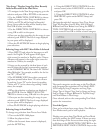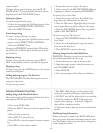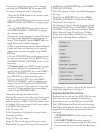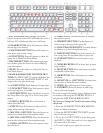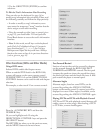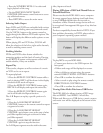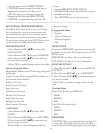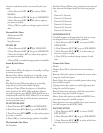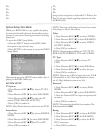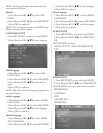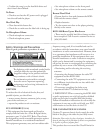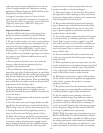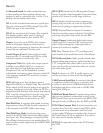
26
5.1 Surround Sound An audio standard that uses
a center speaker, two front speakers and two rear
speakers, as well as a subwoofer (the .1 of the 5.1) to
envelop a movie watcher with sound.
CD An audio and data format that uses optical discs.
Not to be confused with DVDs, though Video CDs
(VCDs) are part of the same family.
CD+G An extension of the Compact Disc standard
that displays graphics while music is playing. A
popular format for karaoke discs. See also CD.
Chapter A part of a movie. DVDs often separate
movies into separate chapters to allow access to
specic scenes or sequences of interest to the viewer. It
is much like an individual CD audio track.
Coaxial Output (Coax) A dedicated digital audio
output used for 5.1 surround sound. e use of this
connection requires a coaxial audio cable.
Component Video One of the video output options
available on your KOD-1000. It is a connection
type often found on high-denition televisions.
Component Video can be identied by its three
multicolored connectors: a green connector marked Y,
a red connector marked Pr/Cr and a blue connector
marked Pb/Cb.
DVD Although at one time the letters stood or
Digital Versatile Disc or Digital Video Disc, the DVD
Forum stated in 1999 that the letters do not stand for
anything. Introduced in the early 1990s, the DVD is a
popular, standard-denition video format that eclipsed
VHS in quality and popularity. It can also carry more
than nine gigabytes of data (on a Dual Layer, DL,
disc) and over 10 times as much music as a CD.
Hard Disk Drive A magnetic disk capable of storing
large amounts of data. Usually found in computers, it
is also featured in the KOD-1000 to store songs.
Hard Disk Drive Mode A mode for using songs
stored on the KOD-1000’s internal hard drive, rather
than from a disc. e advantages of using Hard Disk
Drive Mode is faster access to your karaoke library. To
enter hard drive mode, simply start up the KOD-1000
without a disc.
JPEG ( JPG) Stands for Joint Photographic Experts
Group. A popular computer graphic format that allows
pictures to be shown on a wide range of devices.
MP3 A digital sound format that compresses an
existing song into a le one-tenth its original CD-
Audio size for playing on digital audio products.
NTSC National Television System Committee, a
television encoding system used in the United States
and many other parts of the world. See also PAL.
Optical Output A dedicated digital audio output
usually used for 5.1 surround. e connection uses
pulses of light and requires a ber optic cable to
connect to a receiver or amplier.
PAL Phase Alternate Line, a TV encoding system
used in much of the world, but not the United States.
RCA Cables and Jacks Cables, usually colored white,
red and yellow, that connect an audio/visual device to
a TV or amplier. e yellow cable is used to for the
video signal and the red and white cables are used for
the stereo audio signals.
Track A selection of a CD. It usually means a song
and the two terms are often used interchangeably.
USB (Universal Serial Bus) A connection that allows
a computer or audio/visual device to interface with
a variety of other devices. USB/ash/thumb drives
and laptop hard drives can be used on a KOD-1000
through its USB port.
USB/Flash/umb Drives Computer storage devices
that can carry hundreds or thousands of songs in the
MP3 format. ese can be accessed on the KOD-1000
through its built-in USB port. See also MP3 and USB.
VCD (Video Compact Disc) A video format that uses
compact discs. Not to be confused with DVDs, which
can store much more information and have better
picture quality. While never a popular video format in
the United States, VCDs are popular in Asia and are
also often used in karaoke machines.
VCD 2.0 An improved version of the VCD format.
See VCD.
Glossary



